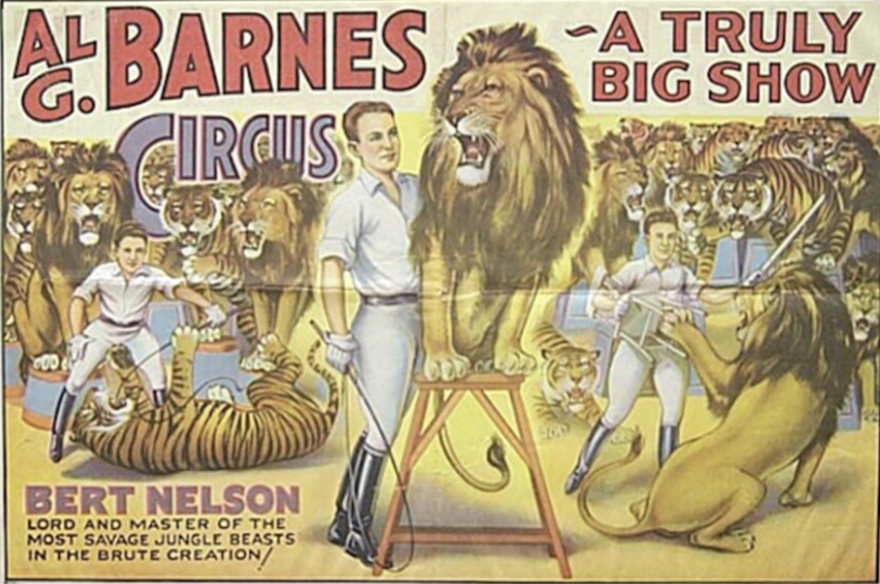Truth matters. Community matters. Your support makes both possible. LAist is one of the few places where news remains independent and free from political and corporate influence. Stand up for truth and for LAist. Make your year-end tax-deductible gift now.
Remember Barnes City in West LA? Probably not — it left town with the circus

Today Culver City is known for its surging restaurant scene and gorgeous art deco buildings.
But 100 years ago, there was another draw: it was the winter home of the immensely popular Al G. Barnes traveling circus and zoo, with a "thousand wild animals", zebras, lions, tigers galore, who, in their downtime, appeared in the nearby film productions.
For a short time, this three square mile area even became its own city, Barnes City, with its own town hall and services.
And then it disappeared.
Barnes City limits
The area today along Washington Boulevard is known officially as the Del Rey neighborhood, and jaggedly straddles the border between Culver City and the city of Los Angeles.
Resident Devora Rogers says she often has difficulties knowing who to call for city services like tree cleaning and trash pick ups. And it was those “wacky” boundaries which got her and her neighbors intrigued.
“ This kind of all made us think about what was this neighborhood before,” she said.
She and her husband did some digging. When she emailed me with its fascinating history, I jumped in to discover just what had happened.
In the early 1900s, the area was simply ranch land before being purchased by Alpheus George Barnes Stonehouse, owner of the Al G. Barnes wild animal circus and zoo.
The entertainment offered was the kind you’d expect in those days: zebras dressed up as clowns, elephants reenacting battlefield scenes and daring human stunts. One “girl trainer” would enter a cage of 30 lions and feed them strips of raw meat with her teeth, according to newspaper reports of the time.
Shows reached as far as Canada and as close as Pasadena and Long Beach. During the winter offseason, the circus stayed around L.A. County. And at the end of the 1920 season, Barnes moved the circus’ permanent winter quarters to his ranch land. The homes and later local zoo were by the corner of Washington Boulevard and McLaughlin Avenue.

While the land was unincorporated, it was right next to the border of the newly created Culver City.
That’s where the circus staff and animals would stay, relatively without issue, until Culver City came knocking in 1925. The city was looking to expand its boundaries and had begun the process of annexing a swath of his land. Barnes tried to stop it in court, arguing it would affect the value of his property and that his front porch would be in Culver City limits while his sleeping rooms would be outside of it.

To get around the annexation, Barnes petitioned the L.A. County Board of Supervisors to permit the area to become its own municipality, to be known as Barnes City.
After much legal and political wrangling, county supervisors set an election in February 1926 for the area’s roughly 400 registered voters, which included much of Barnes’ staff. Cityhood passed with 145 voting in support and 128 opposed.
The ‘political war’
Once the city became officially recognized on Feb. 13, 1926, elected trustees took office. Among those were Barnes’ allies, including his brother Albert T. Stonehouse, who became mayor. But it took less than a month for problems to brew.
Another group of residents, the La Ballona Improvement Association, were unhappy that Barnes’ name — and the name of the circus — had become the moniker of the city. They’d already unsuccessfully challenged it with the L.A. County Board of Supervisors, claiming it would negatively label the area as “Monkeyville.”
This group, and other factions against Barnes, pushed to have a second city election on April 12 in line with state regulations.
During this time, Barnes had been out performing. So he moved his entire circus back home for a one-day stint to allow his 350 performers to vote.
It was a tight race, but it ultimately went against him. Almost all of Barnes’ opponents won official city roles like trustee and city attorney.
Many residents felt there was only one way to deal with the issue of Barnes City: eliminate it and become part of another city. They opposed becoming part of Culver City because of its onerous regulations, but joining the nearby city of L.A. was another option.
So in September 1926, residents voted to merge with Los Angeles.
Barnes City had lasted a mere seven months.
For Rogers, learning the history has been eye-opening.
“ All of us complain about the fact that we don’t know if we’re supposed to call Culver City or L.A.,” she said. “But knowing why that happened is useful. At least it gives us some context.”
It also gives her something to search for. On Rogers' walks, she likes to look for spots that could’ve been interesting fixtures in Barnes City, like a ticket office or an elephant area.
“ I think it’s part of the funny, quirky history of Los Angeles,” she said.












